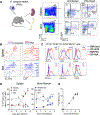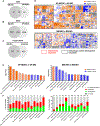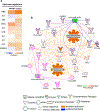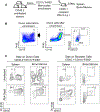Integrative analysis of microRNA and mRNA expression profiles of monocyte-derived dendritic cells differentiation during experimental cerebral malaria
- PMID: 32362022
- PMCID: PMC11215656
- DOI: 10.1002/JLB.1MA0320-731R
Integrative analysis of microRNA and mRNA expression profiles of monocyte-derived dendritic cells differentiation during experimental cerebral malaria
Abstract
Heterogeneity and high plasticity are common features of cells from the mononuclear phagocyte system: monocytes (MOs), macrophages, and dendritic cells (DCs). Upon activation by microbial agents, MO can differentiate into MO-derived DCs (MODCs). In previous work, we have shown that during acute infection with Plasmodium berghei ANKA (PbA), MODCs become, transiently, the main CD11b+ myeloid population in the spleen (SP) and once recruited to the brain play an important role in the development of experimental cerebral malaria (ECM). Here, we isolated 4 cell populations: bone marrow (BM) MOs (BM-MOs) and SP-MOs from uninfected mice; BM inflammatory MOs (BM-iMOs) and SP-MODCs from PbA-infected mice and used a system biology approach to a holistic transcriptomic comparison and provide an interactome analysis by integrating differentially expressed miRNAs (DEMs) and their differentially expressed gene targets (DEGs) data. The Jaccard index (JI) was used for gauging the similarity and diversity among these cell populations. Whereas BM-MOs, BM-iMOs, and SP-MOs presented high similarity of DEGs, SP-MODCs distinguished by showing a greater number of DEGs. Moreover, functional analysis identified an enrichment in canonical pathways, such as DC maturation, neuroinflammation, and IFN signaling. Upstream regulator analysis identified IFNγ as the potential upstream molecule that can explain the observed DEMs-Target DEGs intersections in SP-MODCs. Finally, directed target analysis and in vivo/ex vivo assays indicate that SP-MODCs differentiate in the SP and IFNγ is a main driver of this process.
Keywords: MODC; Plasmodium; cell differentiation; miRNA; systems biology.
©2020 Society for Leukocyte Biology.
Conflict of interest statement
DISCLOSURES
The authors declare no conflicts of interest.
Figures






Similar articles
-
Monocyte-derived dendritic cells in malaria.Curr Opin Microbiol. 2019 Dec;52:139-150. doi: 10.1016/j.mib.2019.08.002. Epub 2019 Sep 19. Curr Opin Microbiol. 2019. PMID: 31542508 Free PMC article. Review.
-
Role of TGF-β and IL-6 in dendritic cells, Treg and Th17 mediated immune response during experimental cerebral malaria.Cytokine. 2016 Dec;88:154-166. doi: 10.1016/j.cyto.2016.08.034. Epub 2016 Sep 12. Cytokine. 2016. PMID: 27632786
-
IL-4 blocks TH1-polarizing/inflammatory cytokine gene expression during monocyte-derived dendritic cell differentiation through histone hypoacetylation.J Allergy Clin Immunol. 2013 Dec;132(6):1409-19. doi: 10.1016/j.jaci.2013.08.039. Epub 2013 Oct 17. J Allergy Clin Immunol. 2013. PMID: 24139608
-
Cannabinoid Receptor 2 Modulates Susceptibility to Experimental Cerebral Malaria through a CCL17-dependent Mechanism.J Biol Chem. 2016 Sep 9;291(37):19517-31. doi: 10.1074/jbc.M116.746594. Epub 2016 Jul 29. J Biol Chem. 2016. PMID: 27474745 Free PMC article.
-
Genetic analysis of cerebral malaria in the mouse model infected with Plasmodium berghei.Mamm Genome. 2018 Aug;29(7-8):488-506. doi: 10.1007/s00335-018-9752-9. Epub 2018 Jun 19. Mamm Genome. 2018. PMID: 29922917 Review.
Cited by
-
Cerebral malaria induced by plasmodium falciparum: clinical features, pathogenesis, diagnosis, and treatment.Front Cell Infect Microbiol. 2022 Jul 25;12:939532. doi: 10.3389/fcimb.2022.939532. eCollection 2022. Front Cell Infect Microbiol. 2022. PMID: 35959375 Free PMC article. Review.
-
The IRAK1/IRF5 axis initiates IL-12 response by dendritic cells and control of Toxoplasma gondii infection.Cell Rep. 2024 Feb 27;43(2):113795. doi: 10.1016/j.celrep.2024.113795. Epub 2024 Feb 15. Cell Rep. 2024. PMID: 38367238 Free PMC article.
-
Itaconate impairs immune control of Plasmodium by enhancing mtDNA-mediated PD-L1 expression in monocyte-derived dendritic cells.Cell Metab. 2024 Mar 5;36(3):484-497.e6. doi: 10.1016/j.cmet.2024.01.008. Epub 2024 Feb 6. Cell Metab. 2024. PMID: 38325373 Free PMC article.
-
Mammalian host microRNA response to plasmodial infection: role as therapeutic target and potential biomarker.Parasitol Res. 2021 Oct;120(10):3341-3353. doi: 10.1007/s00436-021-07293-7. Epub 2021 Aug 23. Parasitol Res. 2021. PMID: 34423387 Review.
References
-
- Le Borgne M, Etchart N, Goubier A, et al. Dendritic cells rapidly recruited into epithelial tissues via CCR6/CCL20 are responsible for CD8+ T cell crosspriming in vivo. Immunity. 2006;24(2):191–201. - PubMed
-
- Lai SM, Sheng J, Gupta P, et al. Organ-specific fate, recruitment, and refilling dynamics of tissue-resident macrophages during blood-stage malaria. Cell Rep. 2018;25(11):3099–3109. - PubMed

